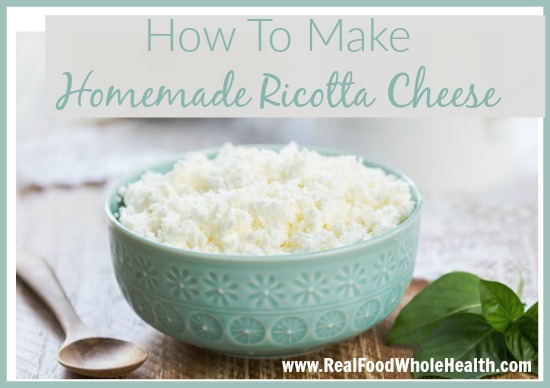
Although ricotta is often made after making mozzarella (using the resulting leftover whey), you can actually make it fresh with a few simple ingredients.
Homemade Ricotta Cheese
by Amy Love, Real Food Whole Health
Ingredients:
1 gallon organic whole milk (not ultrapasteurized/UHT)
¼ cup organic heavy cream
½ cup organic white vinegar (or lemon juice, see notes)
Unrefined sea salt, optional
Directions:
Slowly and gently heat your whole milk over low heat until it reaches 180 degrees Fahrenheit. Stir often to make sure it doesn’t boil or scald. It should take about 20-25 minutes to reach 180 F– If you rush, it can affect your end product.
Once the milk has reached temperature, gently stir in the vinegar (or lemon juice), using a figure 8 stirring pattern and being careful not to over stir.
Remove from heat and let sit for about 10-15 minutes. You should see the curds separating from the whey.
With a slotted spoon, transfer the curds into a colander lined with a thin weave cotton kitchen towel (also called a floursack towel)
Try to keep the curds intact as much as possible.
Drain 45-60 minutes for a more moist ricotta, or put the colander over and bowl and move to the fridge to drain for up 4-8 hours more for a drier ricotta.
You can salt the cheese to your liking, if you prefer. I usually skip this step when I am using the ricotta for sweet applications, like cheesecake.
You can now store the cheese for up to a week, or use right away. We like to use homemade ricotta in gluten free lasagna, on top of pizzas or pasta dishes, in ricotta gnocchi or my favorite- lemon ricotta cheesecake. I even made a chocolate ricotta pudding once. Honestly, it’s delicious with just salt and pepper, too!
Notes:
How do you know when to choose vinegar or lemon juice? You can use either one you’d like for any application, but typically I choose vinegar for more savory uses (like lasagna) and lemon juice for sweeter uses (like my ricotta cheesecake).
Remember not to use ultrapasteurized or UHT milk as it may not result in the desired outcome. We like to start with raw, grassfed, non homogenized milk. It doesn’t stay raw, because you heat the milk, but I feel like it’s a more gentle process. Either way, organic whole milk that isn’t UHT will work.
What to do with the whey? Since it’s not active whey (it’s been heated too high), you can’t save it for making pickles or other ferments. It’s a great addition to creamy soups or stews and makes great pig or chicken feed. You can also use it in place of water for homemade chicken broth, or as a marinade along with herbs and spices for meats.

